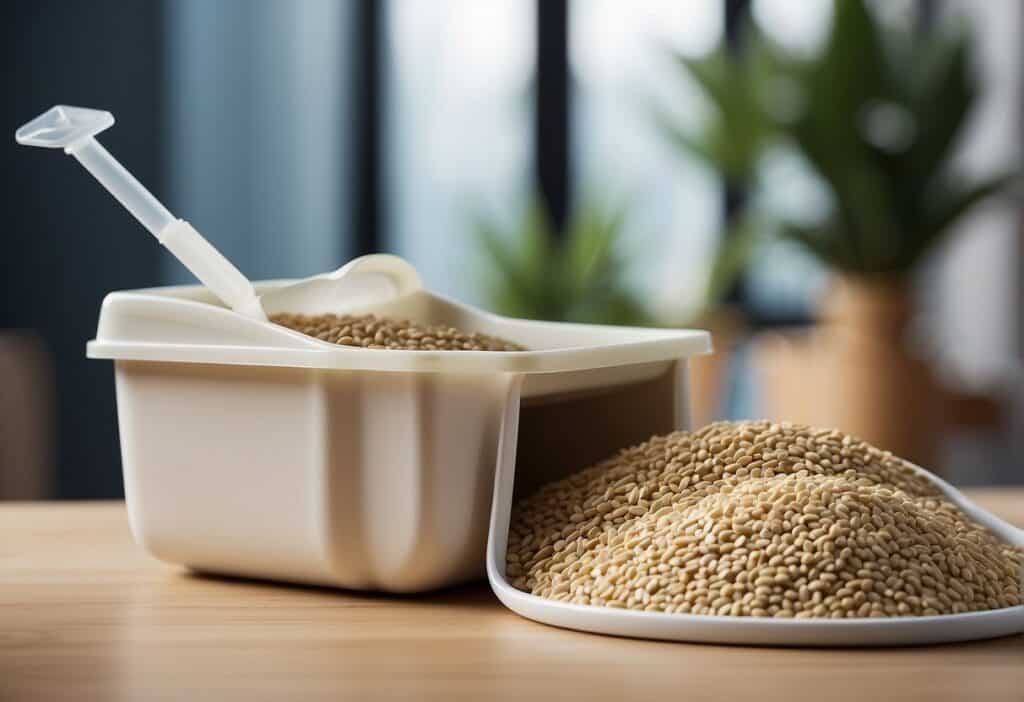How to Collect and Store Cat Pee and Poop for Testing

Collecting and storing your cat’s urine and stool samples for testing is a critical component of routine health management for your feline companion. These samples can provide valuable insights into your pet’s health, revealing issues that might not be apparent through physical exams or behavior. It’s important to gather these samples correctly to ensure that the tests yield accurate results. Your veterinarian depends on uncontaminated samples to make an informed diagnosis, which can be vital for your cat’s overall health.
When it comes to urine collection, you’ll need to prepare appropriately to capture the sample effectively without causing stress to your cat. Opt for non-absorbent litter or a clean, empty litter tray to encourage urination, and then use a syringe or pipette to transfer the urine into a sterile container promptly. For fecal samples, freshness is key. Collecting a sample immediately after your cat has defecated is best for accurate testing. Remember to wear gloves during this process to maintain hygiene and avoid contamination.
Storage of these samples prior to testing is just as crucial. Urine samples should be refrigerated if they cannot be analyzed within an hour, while stool samples are typically fine at room temperature for a short period. However, always consult with your veterinarian for specific instructions on storage and transport, as these can vary depending on the tests that will be performed. Proper collection and storage are not just about getting clear results; they are about ensuring your cat receives the best possible care.
Understanding the Importance of Testing

When you bring your cat’s urine and stool samples to the vet, you are providing essential information that plays a crucial role in maintaining your cat’s health. These samples are vital diagnostic tools that can reveal a great deal about your pet’s well-being.
Identifying Health Issues
Urine and stool samples are fundamental in screening for a variety of health issues in cats. The analysis of these samples can detect symptoms and conditions that may not be evident from a physical examination alone. For instance:
- Diabetes: Urine testing can reveal glucose levels and may indicate diabetes if elevated.
- Kidney Disease: Changes in urine concentration or the presence of proteins can signal kidney problems.
Fecal testing, on the other hand, is the primary method for identifying intestinal parasites, which, if left untreated, can lead to more severe health complications.
Role of Urine and Stool Samples in Diagnosis
The information gleaned from your cat’s urine and stool samples aids the vet in creating an accurate diagnosis. Consider these points:
- Test Results: A comprehensive analysis includes checking for the presence of blood, pH levels, and specific gravity in urine, while stool samples are examined for consistency, color, and the presence of parasites.
- Veterinary Analysis: Vets rely on these test results to identify the root cause of symptoms and craft effective treatment plans.
- Diagnostic Tool: Regular testing can help catch diseases like kidney disease early, where treatment has a higher chance of success.
By understanding the importance of urine and fecal testing, you can better appreciate why your vet recommends them and how they contribute to your cat’s health management.
Preparing for Collection
Before starting the collection process, it’s imperative to have the right tools on hand and to establish a calm setting. This will not only make the process easier for you but also less stressful for your cat.
Choosing the Right Equipment
To collect a urine sample, you’ll need non-absorbent litter to replace your cat’s regular litter. This prevents urine from being absorbed before you can collect it. Disposable gloves are also important to maintain hygiene.
Required Equipment:
- Litter Box: Clean and free from any previous waste.
- Non-Absorbent Litter: Enables the collection of urine without absorption.
- Collection Container: Sterile and with a secure lid.
- Disposable Gloves: To ensure cleanliness during collection.
Creating a Stress-Free Environment
Minimizing stress is crucial for successful sample collection. Perform the collection in a quiet place that your cat frequents often. Allow ample time for your cat to acclimate to the non-absorbent litter before attempting to collect a sample.
Environment Setup:
- Quiet Location: Choose a low-traffic area.
- Familiarity: Use the usual litter box but with non-absorbent litter.
- Patience: Give your cat time to adjust to the changes.
Adhering to these steps will help you gather the necessary samples effectively and with minimal distress to your feline friend.
Collecting the Urine Sample
To ensure the most accurate assessment of your cat’s health, collecting a fresh urine sample is imperative. Using appropriate techniques and handling the sample correctly are key to obtaining reliable test results.
Methods for Urine Collection
Non-absorbing Cat Litter: Start by thoroughly cleaning your cat’s litter box to eliminate any contaminants. Replace your regular litter with non-absorbing cat litter, which is designed to allow urine to pool on the surface for easy collection. After your cat has urinated, use a syringe or pipette to immediately draw the urine from the litter box, avoiding any delay that might alter the sample’s integrity.
Cystocentesis: In some cases, a veterinarian may choose to collect a urine sample directly from the bladder using a procedure called cystocentesis. This involves using a needle and syringe to withdraw urine. This method is generally performed by a professional to ensure the safety and comfort of your cat.
Handling Fresh Urine Samples
Storage: Once you’ve collected the urine, transfer it to a clean container. The container should be sealable to avoid contamination and leaks.
Timeliness: Time is of the essence when handling fresh urine samples. For the most accurate results, deliver the fresh sample to your veterinarian as soon as possible, ideally within 1-2 hours of collection. If immediate testing is not an option, refrigerating the sample can help preserve it for a short time, but always check with your vet on the best approach for storage.
Storing the Urine Sample
Storing your cat’s urine sample correctly is crucial for maintaining its integrity until it can be analyzed. Pay attention to proper labeling and timely refrigeration to ensure accurate test results.
Proper Labeling and Documentation
It is essential to label the urine sample container clearly with your cat’s name, the date, and the time of collection. Use a waterproof label or a marker that won’t smudge or fade. Incorrect labeling can lead to mix-ups or misinterpretation of results.
- Label: Mark the container as follows:
- Cat’s Name: [Your Cat’s Name]
- Date: [MM/DD/YYYY]
- Time: [HH AM/PM]
Temperature and Timing Considerations
Immediately after collection, place the urine sample in a sealed plastic bag to prevent leaks. Then, store it in the refrigerator to maintain appropriate temperature until delivery to the veterinarian.
- Storage Temperature: Keep the sample in the fridge, not the freezer.
- Urine Composition: Refrigeration slows bacterial growth and preserves concentration levels, such as glucose.
- Time Frame: Aim to deliver the sample to your veterinarian within a few hours, as prolonged storage can lead to changes in the urine’s properties.
Collecting the Stool Sample
To accurately diagnose infections like parasites, worms, or protozoa, it’s essential for fecal testing to be conducted on a fresh stool sample collected from your cat. Handling the sample properly is crucial for reliable results.
Techniques for Stool Collection
- Immediate Collection: Collect the stool sample immediately after your cat defecates to ensure freshness. This increases the chances of detecting parasites if they are present.
- Tools: Use a clean plastic scoop or disposable gloves to transfer the feces into a clean container.
- Suitable Containers: A pink container often provided by your vet or a simple sandwich bag can be used for collection.
Ensuring Contamination-Free Samples
- Direct Collection: Try to collect the sample directly into the container to avoid any soil or litter contamination.
- Labeling: Clearly label the container with your cat’s name, your last name, and the date of collection.
- Fecal Flotation: For procedures like fecal flotation, where the stool sample is mixed with a solution to detect parasites, it is essential that no chemicals or foreign matter taint the sample.
Storing the Stool Sample
Stool samples are critical for assessing the digestive health of your cat, allowing for the detection of parasitic infections, viral infections, and other conditions. Proper storage is essential to ensure the sample remains uncontaminated and viable for testing.
Preparing Stool Samples for Storage
First, ensure you have clean plastic gloves and a clean, small plastic container with a tight-sealing lid. Alternatively, you may use unused plastic sandwich bags or specific poop bags provided for this purpose.
- Scoop a fresh stool sample from the litter tray using a designated scoop or the provided gloves.
- Place the sample into your container or bag, ensuring you only collect the stool without extra litter or debris.
- Seal the container or bag immediately to avoid contamination and odor spread.
Optimal Storage Conditions for Fecal Matter
Store the sealed stool sample in your refrigerator, not the freezer, to keep it cool. Here’s how to do this correctly:
| Condition | Details |
|---|---|
| Temperature | Store between 2°C and 4°C (35.6°F – 39.2°F) |
| Storage Time | Ensure it is delivered to the vet within 24 hours |
| Avoid Contamination | Do not store with food; designate a specific area |
Remember, maintaining the sample’s integrity is crucial for accurate results, which is vital for your cat’s health. If these conditions are not met, the reliability of testing can be compromised.
Delivering Samples to the Clinic
Proper delivery of your cat’s urine and stool samples to the clinic is crucial to ensure the accuracy of the test results. Handle the samples with care and communicate effectively with your veterinarian for successful sample analysis.
Transporting Urine and Stool Samples Safely
- Packaging: Place each sample in a separate, leak-proof container. For urine, use a sterile specimen container and for stool, a clean plastic bag or container closed securely.
- Labeling: Clearly label each sample with your cat’s name, your name, and the exact time and date of collection. Use a waterproof pen to avoid smudging.
- Handling: Wear medical gloves while handling samples to prevent contamination and maintain hygiene.
- Stability: Keep the urine sample cool, ideally on ice or a refrigerated pack, especially if the transit time to the clinic is expected to be long.
| Item | Urine Sample | Stool Sample |
|---|---|---|
| Container | Sterile specimen container | Clean plastic bag/container |
| Temperature Control | Keep cool with ice pack | Room temperature is usually acceptable |
Communication with Your Veterinarian
- Pre-Appointment: Contact the clinic to inform them you are bringing in samples and confirm any special instructions for submission.
- Information Transfer: Provide the vet with relevant details such as the time of last feeding, any symptoms observed, and the circumstances of sample collection.
- Carrier: Use a suitable pet carrier for safe transport if you’re bringing your cat along with the samples for further examination.
- Immediate Delivery: Aim to deliver the samples to the veterinary clinic as soon as possible, ideally within a few hours of collection, to preserve their integrity.
| Communication Aspect | Description |
|---|---|
| Pre-Appointment | Call ahead for instructions and to notify of your impending arrival. |
| Details to Provide | Time of feeding, symptoms, collection context. |
| Pet Transport | Ensure your cat’s comfort and safety if they accompany the samples. |
By following these protocols, you can ensure that the urine and stool samples arrive at your vet’s clinic in the best possible condition for testing.
Interpreting Test Results
Your vet has provided you with test results from your cat’s urine and stool samples. Now, it’s time to understand the information given to ensure your cat’s health is properly monitored and managed.
Understanding Urinalysis and Culture Results
A urinalysis is an analysis of your cat’s urine. It can reveal a lot about your cat’s health, including signs of urinary tract infections, kidney problems, diabetes, and more. When interpreting these results, important aspects include:
- Specific Gravity (SG): Reflects how concentrated your cat’s urine is. High levels might indicate dehydration, while low levels can point to kidney issues.
- pH Level: Determines the acidity or alkalinity of the urine. Extreme values can suggest the risk of urinary crystal formation.
- Proteins, Glucose, and Ketones: These should be minimal or absent; their presence could indicate various health issues.
A urine culture tests for bacterial infections. If the culture is positive, it means there’s an infection that likely needs to be treated with antibiotics. The vet clinic may perform a sensitivity test to determine which antibiotic is most effective.
Reading Fecal Test Reports
Fecal tests usually check for the presence of parasites, infections, or digestive problems. Here’s how to read your cat’s fecal test report:
- Parasites: Common ones include roundworms, hookworms, and giardia. Positive results will list the type(s) of parasites found.
- Consistency and Content: Abnormalities in stool consistency or the presence of blood can provide clues to underlying conditions.
- Bacterial Culture: Just like urine, a stool culture identifies bacterial infections, often indicating a need for specific treatments.
Understanding these test results can help you discuss your cat’s health accurately with your vet and assist in determining the next steps for treatment or further analysis. Remember, the accuracy of test results and interpretation is crucial for your cat’s health management.
Tips for Ongoing Health Monitoring
Monitoring your cat’s health through routine check-ups and being alert to behavioral changes can prevent illnesses from escalating. Regular collection and storage of urine and fecal samples for testing are key in maintaining their well-being.
Maintaining Routine Check-Ups
- Frequency of Vet Visits: Schedule visits with your vet at least once a year for a routine health assessment. Cats over the age of seven may benefit from biannual visits.
- Sample Collection: Learn to collect urine and fecal samples. Your vet can guide you on how to do this at home, so you’re prepared if samples are needed between regular visits.
- Record Keeping: Keep a health log with dates and results of all vet visits and tests to track your cat’s health over time.
Observing Behavioral Changes
- Daily Monitoring: Take note of changes in your cat’s appetite, litter box habits, and activity levels. Sudden changes could indicate health issues.
- Stress Indicators: Be aware that changes in behavior may be stress-related. Ensure your home environment is as stress-free as possible to keep your cat happy and healthy.
- Professional Advice: If you observe any behavioral changes, consult your vet promptly for advice. It’s best to catch potential problems early.







